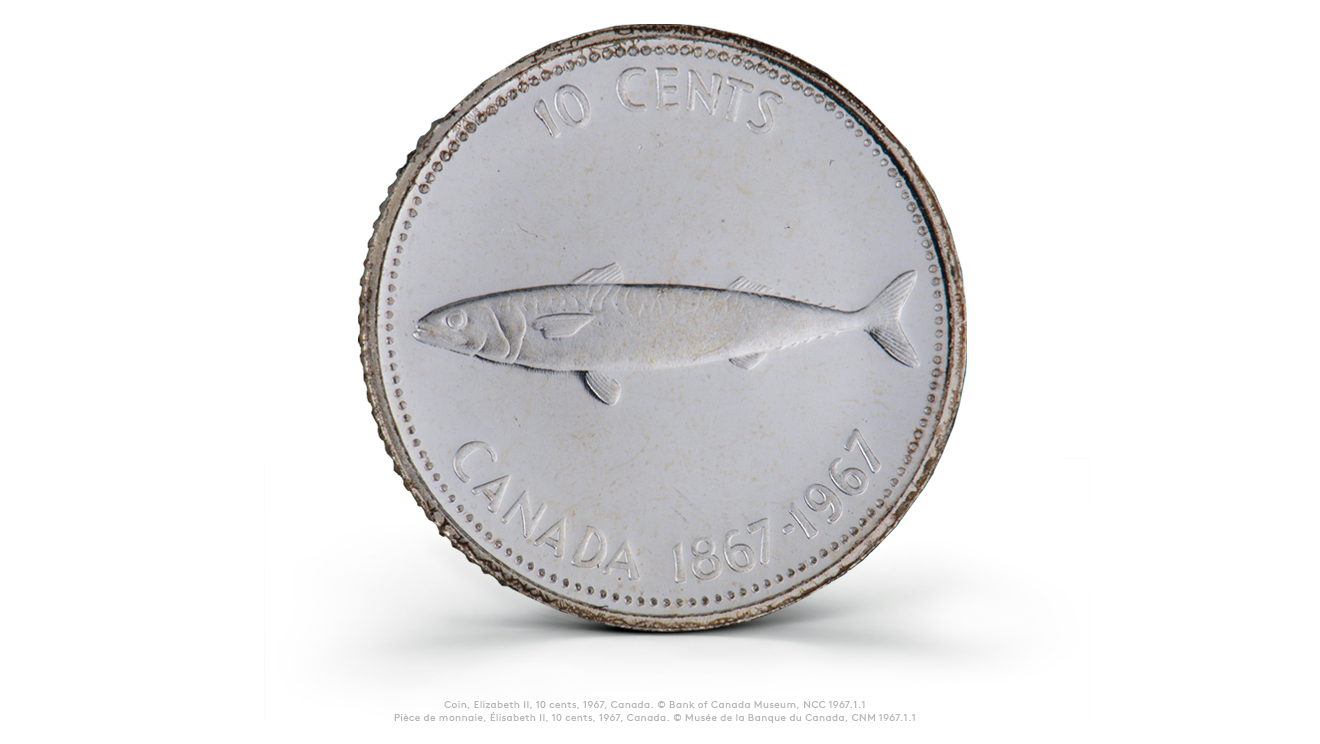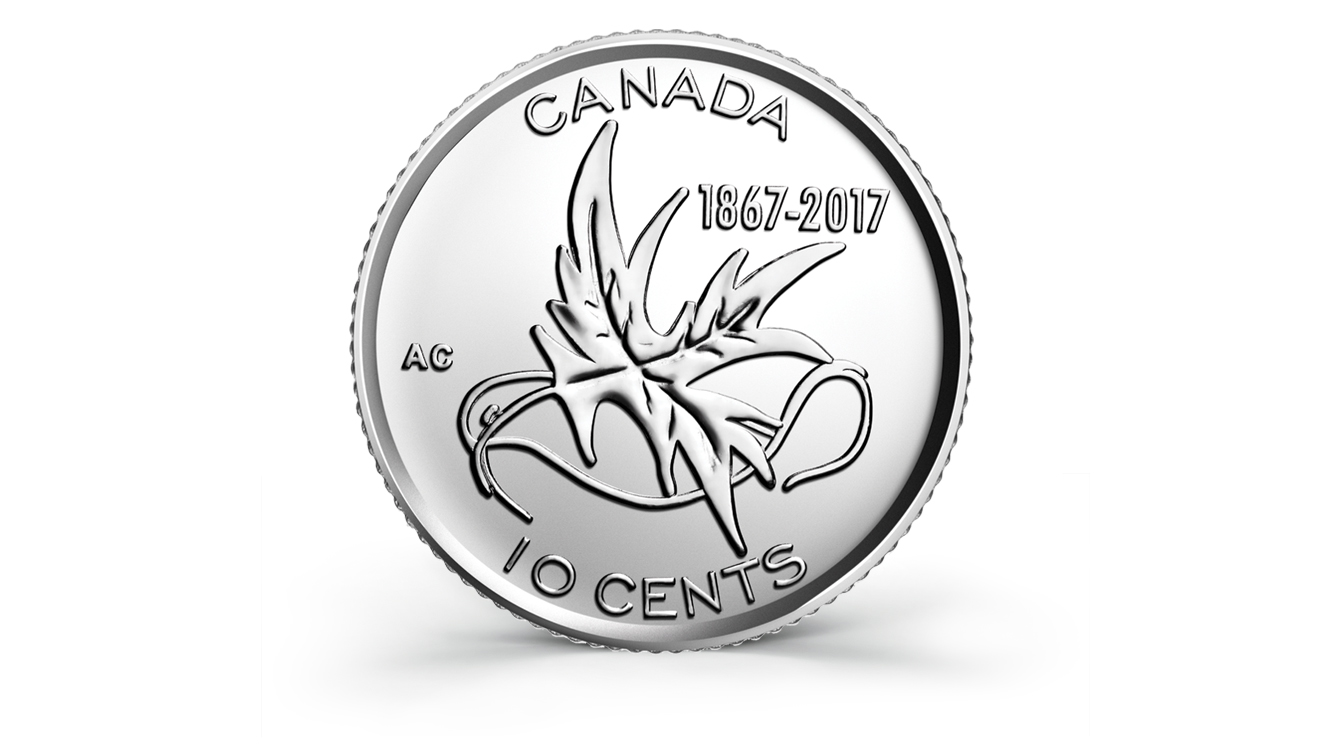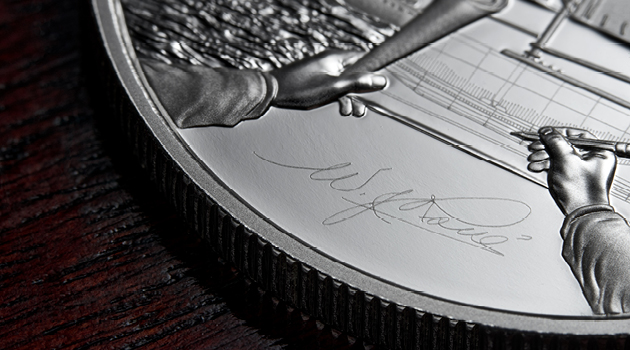The Dime and its Colourful History
- Nov 04, 2021
- History
- 7 MINUTES READ
It might be small, but the history behind Canada’s 10-cent circulation coin featuring the beloved Bluenose is colourful.
Ever since Emanuel Hanh’s design of a “fishing schooner under full sail” was introduced in 1937, it has delighted Canadians with an eloquent reminder of their rich maritime history, and deep connection to the sea.
However, the legacy of Bluenose is not the only tale this little coin has told. In fact, through its designs, it shares many unique stories…


It might be small, but the history behind Canada’s 10-cent circulation coin featuring the beloved Bluenose is colourful.
Ever since Emanuel Hanh’s design of a “fishing schooner under full sail” was introduced in 1937, it has delighted Canadians with an eloquent reminder of their rich maritime history, and deep connection to the sea.
However, the legacy of Bluenose is not the only tale this little coin has told. In fact, through its designs, it shares many unique stories…
Before Bluenose
To get the full story, one must go back to the very beginning. For the 10-cent coin, this brings us back to 1870 when coins minted for the Dominion of Canada fell under the responsibility of the Royal Mint in Britain.
From the late 1800s to 1937, 10-cent coins minted for the Dominion of Canada bore the image of crossed maple boughs tied by a ribbon at the bottom, with a crown at the top. This is how they appeared from the reign of Queen Victoria through to King George V.
It was not until 1936, with the death of King George V and arrival of King Edward VIII, that the Royal Canadian Mint received permission to modernize the reverse images of our coinage.
A contest was launched with the requirement for artists to submit designs that portray national themes like nature, animals and industry. In the end, two artists were selected and Emanuel Hahn’s portrait of Canada’s iconic Bluenose secured a permanent place in time on the Canadian dime.

The Racing Schooner’s Slow Start
Work on the new 1937 coin series that would launch Bluenose into circulation was well underway, but the public would have to wait a little longer for their release. The abdication of Edward VIII in late 1936 meant that more changes were required – the new ‘Canadian’ designs would share a coin with King George VI.
While waiting for matrices with the effigy of the new King to be shipped from overseas, reserves of the 10-cent coin were running low, so an emergency measure was implemented. We would strike the 1936 coins with the effigy of the late King George V, but distinguish them by adding a small dot at the bottom below the bow that tied the crown of maple leaves.
This coin became known as the “1936 Dot Dime” and is one of the rarest Canadian coins ever produced. Only six 1936 Dot Dimes have ever been found, and one was fetched for a princely sum of several thousand dollars.
What happened to the other 1936 Dot Dimes? The search continues…

Bluenose is Born
Finally, the new 10-cent coin was issued in 1937 and proud Nova Scotians were quick to claim the new design as the famous Bluenose, although official documents merely referenced the coin’s design as “a fishing schooner under sail” – there was no mention of its name.
The debate raged for years. It wasn’t until photographs from Emanuel Hahn’s estate surfaced and proved that the famous sculptor did indeed use Bluenose for his design. The coin’s official description was amended in 2002 to include the name of the world famous racing schooner.

The Maple Leaf Coinage
The year was 1948, but the coin says differently. The Bluenose dime had been circulating for just over a decade when India and Pakistan gained independence in 1947. How does this affect Canada? It meant that the Latin inscription ET IND: IMP: found on the obverse of our circulation coins had to be removed since the King was no longer the Emperor of the Indias.
It would take months for new master tools to arrive from the Royal Mint in Britain, and the demand for coins was high. The solution: continue minting the 1947 coins, but add a small maple leaf after the date to identify those with the outdated inscription. This mark is unique to the circulation coins issued that year.

Coins to Celebrate a Centennial
Thirty years following the first redesign of Canadian coins, it was time to do it again. In celebration of the centennial of Confederation in 1967, renowned Canadian artist, Alex Colville brought new life to Canada’s circulation coins with his designs.
Every circulation coin from that year features a simple but striking image of Canadian wildlife. A mackerel was chosen for the dime and in true Colville style, the reason for selecting this beautiful, streamlined fish also included one cryptic phrase—“a symbol of continuity.”
To find its full meaning, one has to go deeper, out to sea, where huge schools of mackerel swim towards the shore and northward along the east coast—an abundant food source that has ensured the continuity of coastal communities for hundreds of years.
1967 also marked a change in the composition of Canadian coinage, reducing silver content from 80% to 50%. The composition changed further in 1968 to nickel.

The Coin that Fuelled Philanthropy
Canada’s dime also ensured the continuity of families affected by polio in the 1950s.
At the time, a dime had the purchasing power of more than today’s loonie, and mothers across Canada went door to door collecting dimes to fund research for a cure. The March of Dimes had a direct impact on the development of a vaccine, yet the mothers carried on, building a support network for people with physical challenges that endures to this day.
By 2001, the philanthropic work of Canadians equalled 578,000 full-time jobs, and the International Year of Volunteers was celebrated with a special commemorative design on the 10-cent coin—a numismatic interpretation of the original “marching mothers” with rays of sunshine signifying the hope that philanthropy brings to the world.

A Dime Designed by and Selected by Canadians
For Amy Choi of Calgary (Alberta), hope is found in the Canadian ideals of peace, co-operation and diversity. In 2015, her design was one of 10,000 submissions received through the My Canada, My Inspiration contest in celebration of Canada’s 150th anniversary of Confederation.
The dime, now Canada’s smallest coin, became the canvas for Choi’s design. Wings of Peace expresses her hope that one day, offering a maple leaf will be as symbolic as offering an olive branch. Choi is the first-ever woman to have designed a winning image for Canada’s 10-cent coin. Watch Choi describe her design here.
Did you know that the 10-cent coin was once larger than the nickel? That’s right. In the early 1900s and before, coins were sized according to their metal value. But in 1922, the composition of the 5-cent coin changed from silver to nickel, and its size increased to make it more manageable.
What about Canada’s 125th anniversary? In 1992, all Canadian circulation coins kept their classic design but boasted a double-date: 1867-1992. On the dime, the year 1867 is struck to the left side of Bluenose and the year 1992 to the right.

Back to Where it all Began
The year 2021 marks the 100th anniversary of the launch of Bluenose, the Grand Banks fishing schooner whose racing feats and indomitable spirit earned it the title of “Queen of the North Atlantic.”
What better way to celebrate the legacy of our beloved Bluenose? By transforming its everlasting canvas into a Canadian first - our first ever coloured dime.
On this centennial anniversary, Bluenose’s spirit lives on in the hearts (and pockets) of Canadians, and on the 2021 commemorative 10-cent circulation coin . This special issue offers a fresh take on a familiar portrait — it shows a newly completed, freshly launched Bluenose in all its glory, with the wind filling its sails as it races across the blue sea.
Don’t just look for this coloured version. A non-coloured version of the same image, as well as a double-dated version of the classic Bluenose dime are also floating around – three different versions of the 2021 Bluenose commemorative dimes!

Historic Designs
Canada’s dime may be small change, but the stories it shares through its designs hold great historical and commemorative value that, in the case of the 1936 Dot Dime, are priceless.
Which of these historical coins have you held on to? Keep track of your 10-cent circulation coin collection with this infographic. Click on the image below to download.
‘Bluenose’ is an official mark adopted and used by the Nova Scotia Department of Communities, Culture and Heritage pursuant to the Trade-marks Act (Canada). It is used by the Royal Canadian Mint with the Department’s permission.
Image credit: A special thanks to the © Bank of Canada Museum for the use of images dated 1992 and earlier from their Collection.


Holding on to the legacy of Bluenose
In a sea of animal-themed coin designs, the ship on Canada’s 10-cent piece instantly stands out. Those who don’t know the story of Bluenose may wonder why a two-masted schooner still resonates with us today, but generations of Canadians have carried the image of Bluenose in their pockets, and they also carry the ship’s story in their hearts. They know this treasured and iconic image as a representation of Canada’s maritime history and fishing industry, but in the minds of many Canadians, Bluenose means something more.


Launching a legacy: Bluenose at 100
Imagine the excitement of seeing a newly built Bluenose take to the waters for the very first time! It happened 100 years ago, on March 26, 1921, at Lunenburg, N.S., where a large crowd of onlookers erupted into cheers when Bluenose was officially launched. Test your Launch Day knowledge with these trivia questions!


William J. Roué: The vision behind Bluenose
William James Roué (1879-1970) is the visionary who gave Bluenose the gift of elegance and speed by designing a workhorse that could – and would – outrace all others. His greatest legacy is etched onto the hearts and minds of Canadians, and our 10-cent coin too, where Bluenose sails on as a proud symbol of Canadian ingenuity and craftsmanship.




